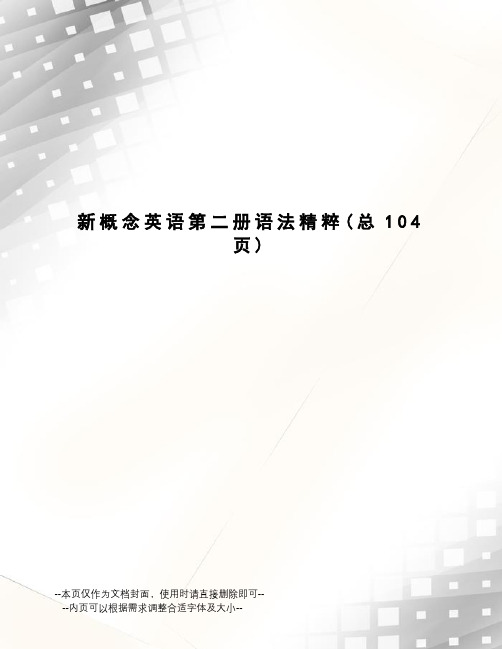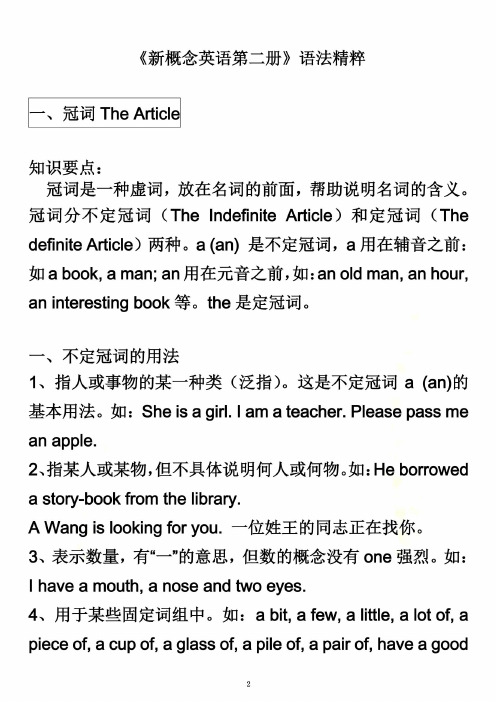《新概念英语》第二册语法精粹
- 格式:doc
- 大小:900.00 KB
- 文档页数:99

新概念英语第二册语法精粹(总104页)--本页仅作为文档封面,使用时请直接删除即可----内页可以根据需求调整合适字体及大小--《新概念英语第二册》语法精粹知识要点:冠词是一种虚词,放在名词的前面,帮助说明名词的含义。
冠词分不定冠词(The Indefinite Article)和定冠词(The definite Article)两种。
a (an) 是不定冠词,a用在辅音之前:如a book, a man; an用在元音之前,如:an old man, an hour, an interesting book等。
the是定冠词。
一、不定冠词的用法1、指人或事物的某一种类(泛指)。
这是不定冠词a (an)的基本用法。
如:She is a girl. I am a teacher. Please pass me an apple.2、指某人或某物,但不具体说明何人或何物。
如:He borrowed a story-book from the library.A Wang is looking for you. 一位姓王的同志正在找你。
3、表示数量,有“一”的意思,但数的概念没有one强烈。
如:I have a mouth, a nose and two eyes.4、用于某些固定词组中。
如:a bit, a few, a little, a lot of, a piece of, a cup of, a glass of, a pile of, a pair of, have a good time, for a while, for a long time等。
5、用在抽象名词前,表具体的介绍——a + 抽象名词,起具体化的作用。
如:This little girl is a joy to her parents. 这女孩对她父母来说是一个乐趣。
It is a pleasure to talk with you. 跟您交谈真是一件愉快的事情。

新概念英语》第二册语法精粹D《新概念英语第二册》语法精粹一、冠词The Article知识要点:冠词是一种虚词,放在名词的前面,帮助说明名词的含义。
冠词分不定冠词(The Indefinite Article)和定冠词(The definite Article)两种。
a (an) 是不定冠词,a用在辅音之前:如a book, a man; an用在元音之前,如:an old man, an hour, an interesting book等。
the是定冠词。
一、不定冠词的用法1、指人或事物的某一种类(泛指)。
这是不定冠词a (an)的基本用法。
如:She is a girl. I am a teacher. Please pass me an apple.2、指某人或某物,但不具体说明何人或何物。
如:He borroweda story-book from the library.A Wang is looking for you. 一位姓王的同志正在找你。
3、表示数量,有“一”的意思,但数的概念没有one强烈。
如:I have a mouth, a nose and two eyes.4、用于某些固定词组中。
如:a bit, a few, a little, a lot of, a piece of, a cup of, a glass of, a pile of, a pair of, have a goodtime, for a while, for a long time等。
5、用在抽象名词前,表具体的介绍——a + 抽象名词,起具体化的作用。
如:This little girl is a joy to her parents. 这女孩对她父母来说是一个乐趣。
It is a pleasure to talk with you. 跟您交谈真是一件愉快的事情。
It is an honour to me to attend the meeting. 参加这个会,对我来说是一种荣誉。

新概念第二册每课的语法重点整理第1课- 介词的用法:in, on, at 等表示时间、地点和方式的介词的用法和区别。
第2课- 被动语态: 被动语态的构成和用法,如何将主动句改写为被动句。
第3课- 不定代词:some, any, no, every等不定代词的用法和区别。
第4课- 动词的时态:一般现在时,一般过去时以及一般将来时的构成和用法。
第5课- 非谓语动词:动词不定式、动名词和分词的形式和用法。
第6课- 数量的表达:基数词和序数词,还有一些常见的数量词的用法。
第7课- 情态动词:can, could, may, might等情态动词的用法。
第8课- 连词的使用:and, but, or, so等连接词的用法和区别。
第9课- 名词的所有格:名词所有格的构成和用法,以及经典的名词所有格的错误用法。
第10课- 现在完成时:现在完成时的构成和用法,与一般过去时的区别。
第11课- 介词短语:介词短语作状语的用法和常见表达方式。
第12课- 虚拟语气:if条件句和虚拟语气的构成和用法。
第13课- 比较级和最高级:形容词和副词的比较级和最高级的构成和用法。
第14课- 状语从句:时间、地点、原因、条件等状语从句的引导词和用法。
第15课- 间接引语:直接引语和间接引语的转换和用法。
第16课- 冠词的使用:冠词a, an和the的用法和区别。
第17课- 时态的混合使用:不同时态的混合使用,如何表达不同的时间关系。
第18课- 直接引语:如何准确地引述他人的原文,注意引号和标点的使用。
第19课- 句型的使用:如何正确地使用倒装句、感叹句和祈使句。
第20课- 能愿动词:能愿动词的构成和用法,如何表达能力和意愿。
第21课- 主谓一致:主谓一致的原则和方法。
第22课- 介词的构成:介词形式的构成和用法,以及常见的介词短语。
第23课- 代词的使用:人称代词、物主代词和不定代词的用法和区别。
第24课- 婉转的表达:如何用委婉的方式表达意见、请求和建议。


新概念英语第二册语法精粹及练习(一)新概念二册语法精粹一、一般现在时一、一般现在时:1.构成:使用动词原形,第三人称单数须有变化。
(1)直接加“s”,works,takes(2)以辅音加“y”结尾,变“y”为“i”,再加“es”,carry → carries(3)以“o, s, x, ch, sh”结尾的动词加“es”, goes dresses watches brushes2.功能:(1)表现在的事实、状态或动作:eg: Birds fly.She loves music.Mary's parents get up very early.(2)表习惯性动作或职业,常与often,sometimes,usually,always,every week,seldom,occasionally,frequently等时间副词连用。
eg: I always take a walk after supper.She writes to me very often.Tom and his girlfriend go out to take a picnic occasionally.(3)表客观真理,格言警句或事实:The earth moves round the sun.The sun rises in the east and sets in the west.Two and two makes four.No man but errs. 人非圣贤,熟能无过。
(4)表将来:A.在由when,after, before,as,as soon as,although,because,if,even if,in case,till,until,unless,so long as, where, whatever,wherever 等引导的状语从句中用一般现在时表将来发生的动作。
(黄金重点,所有考试都不放过它!)例如:I'll tell her when shecomes tomorrow.Even ifit rains this afternoon, I'll meet you.Whatever happens, you should keep cool-headed. (不错的句型,背下!!)I'll be right here waiting for you wherever you go.(很感人的句型!)B.按时间表示将要发生的动作或事件,用一般现在时表达将来时概念。

《新概念英语第二册》语法总结一、冠词The Article知识要点:冠词是一种虚词,放在名词的前面,帮助说明名词的含义。
冠词分不定冠词(The Indefinite Article)和定冠词(The definite Article)两种。
a (an) 是不定冠词,a用在辅音之前:如a book, a man; an用在元音之前,如:an old man, an hour, an interesting book等。
the是定冠词。
一、不定冠词的用法1、指人或事物的某一种类(泛指)。
这是不定冠词a (an)的基本用法。
如:She is a girl. I am a teacher. Please pass me an apple.2、指某人或某物,但不具体说明何人或何物。
如:He borrowed a story-book from the library.A Wang is looking for you. 一位姓王的同志正在找你。
3、表示数量,有“一”的意思,但数的概念没有one强烈。
如:I have a mouth, a nose and two eyes.4、用于某些固定词组中。
如:a bit, a few, a little, a lot of, a piece of, a cup of, a glass of, a pile of, a pair of, have a good time, for a while, for a long time等。
5、用在抽象名词前,表具体的介绍——a + 抽象名词,起具体化的作用。
如:This little girl is a joy to her parents. 这女孩对她父母来说是一个乐趣。
It is a pleasure to talk with you. 跟您交谈真是一件愉快的事情。
It is an honour to me to attend the meeting. 参加这个会,对我来说是一种荣誉。
新概念第二册语法知识点汇总一、时态。
1. 一般现在时。
- 用法:- 表示经常的或习惯性的动作。
例如:He often gets up at six o'clock.(他经常六点钟起床。
)- 表示客观事实或普遍真理。
The earth moves around the sun.(地球绕着太阳转。
)- 结构:- 主语为第三人称单数(he/she/it等)时,动词要加 -s或 -es。
如:She likes reading.(她喜欢阅读。
)- 主语为其他人称时,动词用原形。
I play football every weekend.(我每个周末踢足球。
)2. 一般过去时。
- 用法:- 表示过去某个时间发生的动作或存在的状态。
I saw him yesterday.(我昨天见到他了。
)- 结构:- 动词一般用过去式,规则动词的过去式一般在词尾加 -ed,如:work - worked。
不规则动词有特殊的过去式形式,如:go - went,see - saw。
3. 现在进行时。
- 表示现在正在进行的动作。
Look! She is dancing.(看!她正在跳舞。
)- 结构:- be动词(am/is/are)+动词的 -ing形式。
He is reading a book.(他正在读一本书。
)4. 过去进行时。
- 用法:- 表示过去某个时刻或某段时间正在进行的动作。
At that time yesterday, I was doing my homework.(昨天那个时候,我正在做家庭作业。
)- 结构:- was/were+动词的 -ing形式。
They were playing football at threeo'clock yesterday afternoon.(他们昨天下午三点正在踢足球。
)5. 现在完成时。
- 用法:- 表示过去发生的动作对现在造成的影响或结果。
I have lost my key.(我把钥匙丢了。
新概念英语第二册语法知识点汇总本文档将对《新概念英语第二册》中的语法知识点进行汇总。
以下是该册教材中的重要语法知识点:1. 时态- 现在完成时:表示过去发生的事情对现在产生的影响,构成为"have/has + 过去分词"。
- 过去完成时:表示过去某个时间或事件之前发生的动作或状态,构成为"had + 过去分词"。
- 将来进行时:表示将来某个时间正在进行的动作,构成为"will be + 动词-ing"。
2. 句型- There be句型:表示某处存在某物或某人,构成为"There + be 动词 + 宾语"。
- 虚拟语气:表示与事实相反的假设、愿望或建议的语气,构成为"if + 主语 + 过去式,主语 + would/could/might + 动词原形"。
3. 名词- 可数名词与不可数名词:可数名词可以同时使用单复数形式,而不可数名词只能使用单数形式。
- 复合名词:由两个或更多个词构成的名词,如"homework"、"football"等。
4. 冠词- 定冠词:表示特指的冠词,如"the"。
- 不定冠词:表示泛指的冠词,如"a/an"。
5. 代词- 主格代词:在句子中作主语,如"I"、"you"等。
- 宾格代词:在句子中作宾语,如"me"、"you"等。
- 物主代词:表示所属关系的代词,如"my"、"your"等。
6. 动词- 不定式:表示动作的动词原形,可以作主语、宾语等,如"to eat"。
- 动词的时态变化:根据不同的时态,在动词前加不同的助动词,如"is/am/are"表示现在进行时。
《新概念英语第二册》语法精粹知识要点:冠词是一种虚词,放在名词的前面,帮助说明名词的含义。
冠词分不定冠词(The Indefinite Article)和定冠词(The definite Article)两种。
a (an) 是不定冠词,a用在辅音之前:如a book, a man; an用在元音之前,如:an old man, an hour, an interesting book等。
the是定冠词。
一、不定冠词的用法1、指人或事物的某一种类(泛指)。
这是不定冠词a (an)的基本用法。
如:She is a girl. I am a teacher. Please pass me an apple.2、指某人或某物,但不具体说明何人或何物。
如:He borrowed a story-book from the library.A Wang is looking for you. 一位姓王的同志正在找你。
3、表示数量,有“一”的意思,但数的概念没有one强烈。
如:I have a mouth, a nose and two eyes.4、用于某些固定词组中。
如:a bit, a few, a little, a lot of, a piece of, a cup of, a glass of, a pile of, a pair of, have a good time, for a while, for a long time等。
5、用在抽象名词前,表具体的介绍——a + 抽象名词,起具体化的作用。
如:This little girl is a joy to her parents. 这女孩对她父母来说是一个乐趣。
It is a pleasure to talk with you. 跟您交谈真是一件愉快的事情。
It is an honour to me to attend the meeting. 参加这个会,对我来说是一种荣誉。
《新概念英语第二册》语法总结知识要点:冠词是一种虚词,放在名词的前面,帮助说明名词的含义。
冠词分不定冠词(The Indefinite Article)和定冠词(The definite Article)两种。
a (an) 是不定冠词,a用在辅音之前:如a book, a man; an用在元音之前,如:an old man, an hour, an interesting book等。
the是定冠词。
一、不定冠词的用法1、指人或事物的某一种类(泛指)。
这是不定冠词a (an)的基本用法。
如:She is a girl. I am a teacher. Please pass me an apple.2、指某人或某物,但不具体说明何人或何物。
如:He borrowed a story-book from the library.A Wang is looking for you. 一位姓王的同志正在找你。
3、表示数量,有“一”的意思,但数的概念没有one强烈。
如:I have a mouth, a nose and two eyes.4、用于某些固定词组中。
如:a bit, a few, a little, a lot of, a piece of, a cup of, a glass of, a pile of, a pair of, have a good time, for a while, for a long time等。
5、用在抽象名词前,表具体的介绍——a + 抽象名词,起具体化的作用。
如:This little girl is a joy to her parents. 这女孩对她父母来说是一个乐趣。
It is a pleasure to talk with you. 跟您交谈真是一件愉快的事情。
It is an honour to me to attend the meeting. 参加这个会,对我来说是一种荣誉。
《新概念英语第二册》语法精粹知识要点:冠词是一种虚词,放在名词的前面,帮助说明名词的含义。
冠词分不定冠词(The Indefinite Article)和定冠词(The definite Article)两种。
a (an) 是不定冠词,a用在辅音之前:如a book, a man; an用在元音之前,如:an old man, an hour, an interesting book等。
the 是定冠词。
一、不定冠词的用法1、指人或事物的某一种类(泛指)。
这是不定冠词a (an)的基本用法。
如:She is a girl. I ama teacher. Please pass me an apple.2、指某人或某物,但不具体说明何人或何物。
如:He borrowed a story-book from the library.A Wang is looking for you. 一位姓王的同志正在找你。
3、表示数量,有“一”的意思,但数的概念没有one强烈。
如:I have a mouth, a nose and two eyes.4、用于某些固定词组中。
如:a bit, a few, a little, a lot of, a piece of, a cup of, a glass of, a pile of,a pair of, have a good time, for a while, for a long time等。
5、用在抽象名词前,表具体的介绍——a + 抽象名词,起具体化的作用。
如:This little girl is a joy to her parents. 这女孩对她父母来说是一个乐趣。
It is a pleasure to talk with you. 跟您交谈真是一件愉快的事情。
It is an honour to me to attend the meeting. 参加这个会,对我来说是一种荣誉。
二、定冠词的用法:1、特指某(些)人或某(些)事物。
这是定冠词the的基本用法。
如:Beijing is the capital of China.The pen on the desk is mine.2、指谈话双方都知道的人或事物。
如:Where is the teacher?Open the window, please.3、指上文提过的人或事物(第二次出现)。
如:There was a chair by the window. On the chair sat a young woman with a baby in her arms.The baby was thin.4、用在世界上独一无二的事物前。
如:the earth, the moon, the sun.5、用在序数词和形容词最高级前。
(副词最高级前的定冠词可省略)如:He is always the first to come to school.Bob is the tallest in his class.6、用在某些专有名词前(由普通名词构成的专用名词)。
如:the Great Wall, the Summer Palace, the Science Museum, the Children’s Palace, the Party等。
7、用在一些习惯用语中。
如:on the day, in the morning (afternoon, evening), the day after tomorrow, the day before yesterday, the next year, by the way等。
8、用在江河湖海、山脉前。
如:the Yellow River, the Pacific Ocean, the Alps, the Himalayas9、用在报刊、杂志前。
如:the People’s Daily, the Evening Paper, the Times 泰晤士报。
10、表示某一家人要加定冠词。
如:The Browns are at home to receive visitors today. 布朗一家今天要接待客人。
11、用在形容词前,表某一类人。
如:the poor, the wounded, the living, the dead, the rich, the sick 等。
12、定冠词可以表示一事物内部的某处。
如:The driver always sits in the front of the bus(car).三、零冠词(即不用冠词):(来源:给力英语网)1、专用名词和不可数名词前。
如:China, America, Grade One, Class Two, milk, oil, water, paper, science等。
2、名词前已有作定语用的this, that, my, your, some, any等代词。
如:Go down this street.3、复数名词表示一类人或事物时。
如:We are students. I like reading stories.4、节日、日期、月份、季节前。
如:Teachers’ Day, Children’s Day, National Day, in summer, in July等。
Today is New Year’s Day. It is Sunday. March 8 is Women’s Day.5、在称呼语或表示头衔的名词前,尤其作表语、宾补时。
如:What’s the matter, Granny? We elected him monitor.6、在某些习惯用语中的名词前。
如:at noon, at night, at first, at last, at most, at least, by bus(train, air, sea), in bed, in time, in front of, go to school, go to bed, go to college, on foot, at table, in ink, in pencil等。
7、在三餐饭和球类运动前。
如:She goes to school after breakfast every morning.We are going to play football.We usually have lunch at school.8、科目前不加。
如:We learn Chinese, maths, English and some other subjects.【专项训练】:1、We can’t live without air.A.an B.×C.the D.some2、——Have you seen pen? I left it here this morning.——Is it black one? I think I saw it somewhere.A.a; the B.the; the C.the; a D.a; a3、I’ve been waiting for him for hour and half.A.×; ×B.the; a C.a; the D.an; a4、What fine weather we have today!A.a B.×C.some D.an5、Have you ever seen as tall as this one?A.a tree B.such tree C.an tree D.tree6、Children usually go to school at age of six.A.×; the B.a; an C.the; ×D.the; the7、Himalayas is highest mountain in world.A.×; the;×B.The; the; the C.A; a; a D.×;×;×8、They each have __book. Li Hua’s is about writer. Wang Lin’s is on science.A.a; a; ×B.the; ×; the C.×; the; ×D.a; the; a9、Physics is science of matter and energy.A.The; ×B.×; ×C.×; the D.A; a10、sun rises in east and sets in west.A.A; an; a B.The;×;× C.The; the; the D.A; the; a11、Many people agree that__knowledge of English is a must in international trade today.A.a;×B.the; an C.the; the D.×; the12、__Mr Jones called while you were out (neither of us knows this man). He was in badtemper. A.×;a B.A;×C.The; the D.A; a13、They were at dinner then. It was delicous one.A.a; the B.×;×C.×;a D.a; a14、what kind of car do you want to buy?A.×B.the C.a D.an15、Alice is fond of playing piano while Henry is interested in listening to music.A.×; the B.×;×C.the; ×D.the; the16、Beyond stars, the astronaut saw nothing but space.A.the; ×B.×; the C.×;×D.the; the17、Alexander Graham Bell invented telephone in 1876.A.×B.a C.the D.one18、——Where’s Jack?——I think he’s still in bed, but he might just be in bathroom.A.×;×B.the; the C.the; ×D.×; the19、Many people are still in habit of writing silly things in public places.A.the; the B.×;×C.the; ×D.×; the20、——I’d like information about the management of your hotel, please.——Well, you could have word with the manager. He might be helpful.A.some; a B.an; some C.some; some D.an; a【答案】:1、B air是不可数名词。